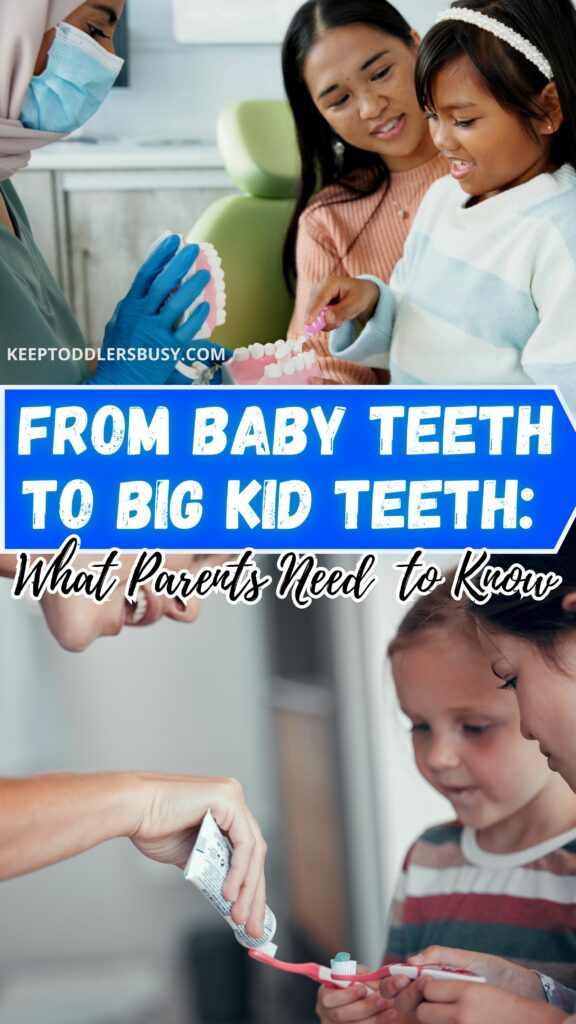
From Baby Teeth to Big Kid Teeth: What Parents Need to Know
A child’s smile is a treasure that deserves the utmost care. From personal experience, it can be a daunting task to make sure that we are taking enough time out to continuously do all the steps need to ensure optimal dental care.
But strong, healthy teeth are crucial for a child’s overall well-being, affecting everything from eating and speaking to self-confidence. So when those days are long and we just want to get our kiddies in the bed, I try to remember that the habits we commit to today, will ensure a healthy future for our kids.
This guide focuses on essential dental care information for parents, covering the journey from the first tooth to a confident adolescent smile!

Key Insights:
- Good oral hygiene starts early: Establish healthy dental habits from infancy.
- Teething is a normal phase, but proper care can ease discomfort.
- Regular dental check-ups are crucial for monitoring oral health.
- Nutrition plays a vital role in tooth development and decay prevention.
- Address dental anxiety and orthodontic concerns early for optimal results.
Teething Process
Teething is a normal part of a baby’s development, but it can be uncomfortable for both the child and the parent. Typically starting around six months, teething occurs when a baby’s teeth begin to push through their gums.
Signs and Symptoms of Teething
While not every baby experiences the same symptoms, common signs of teething include:
- Irritability and fussiness: Your baby might be crankier than usual.
- Drooling: Increased saliva production is common during teething.
- Chewing: Your baby may want to chew on everything from toys to their own hands.
- Swollen and tender gums: You might notice red, puffy gums.
- Difficulty sleeping: Teething discomfort can disrupt sleep patterns.
- Reduced appetite: Your baby might eat less due to gum soreness.
It’s essential to note that while a low-grade fever and mild diarrhea can sometimes accompany teething, these symptoms should not be severe or prolonged. If your baby has a high fever, persistent diarrhea, or other concerning symptoms, consult your pediatrician.
Tips for Soothing Teething Pain
Here are some gentle ways to ease your baby’s teething discomfort:
- Cold relief: Offer your baby a chilled teething ring or a clean, damp washcloth. The cold can numb sore gums.
- Gentle massage: Gently massage your baby’s gums with a clean finger.
- Over-the-counter pain relievers: Consult your pediatrician about using infant-safe pain relievers like acetaminophen or ibuprofen.
- Distraction: Engage your baby in playtime or other activities to divert attention from teething pain.
Common Myths About Teething
There are many old wives’ tales about teething. Here are a few common myths:
- Teething causes high fever: While a slightly elevated temperature is possible, a high fever is usually unrelated to teething.
- Teething causes ear infections: Earaches can occur during teething, but they are often unrelated.
- Teething causes rashes: Teething might increase drooling, leading to a rash around the mouth, but it doesn’t cause other types of rashes.
Every baby is different, and teething experiences can vary. If you’re concerned about your baby’s discomfort or if symptoms worsen, always consult your pediatrician.
Early Dental Care
Starting good oral hygiene habits early is crucial for a lifetime of healthy smiles. Here’s what parents need to know.
First Dental Visit
The American Dental Association (ADA) recommends scheduling your child’s first dental visit by their first birthday or within six months of their first tooth erupting. This early visit helps establish a positive dental experience and allows your dentist to assess your child’s oral health and provide guidance on proper care.
During the initial visit, the dentist will gently examine your child’s mouth, teeth, and gums. They will also discuss oral hygiene practices, such as brushing and flossing, and answer any questions you may have.
How to Brush a Toddler’s Teeth
Until your child can effectively brush their teeth on their own (usually around age six or seven), parents or caregivers should assist with brushing. Here’s how:
- Use a soft-bristled toothbrush: Choose a toothbrush with a small head designed for children.
- Apply a pea-sized amount of fluoride toothpaste: For children younger than three, use a smear of toothpaste.
- Gentle circular motions: Brush all tooth surfaces, including the chewing surfaces, inner surfaces, and outer surfaces.
- Clean the tongue: Gently brush your child’s tongue to help remove bacteria.
Make brushing fun by turning it into a game or singing a short song while you brush. Positive reinforcement can help your child develop good oral hygiene habits.
Transition from Baby Teeth to Permanent Teeth

As your child grows, their baby teeth will gradually make way for their adult, or permanent, teeth. This process, while exciting, can also raise questions.
Timeline for the Loss of Baby Teeth
The typical timeline for losing baby teeth starts around age six and continues until about age 12. However, every child develops at their own pace, so there can be variations. Generally, the order of tooth loss follows the same pattern as when the baby teeth erupted: the front teeth are usually the first to go.
What to Expect During This Transition
As permanent teeth start to emerge, you might notice some changes in your child’s mouth:
- Gaps: Spaces will appear between baby teeth as they loosen and prepare to fall out.
- Loose teeth: Your child will likely experience wiggly teeth. It’s natural for them to want to play with these loose teeth, but it’s important to discourage them from pulling them out prematurely.
- Permanent teeth coming in: Behind the loose baby teeth, you’ll start to see the new adult teeth pushing through.
Common Issues
While most children go through this transition smoothly, some common issues may arise:
- Wiggly teeth: As mentioned, it’s normal for baby teeth to become loose. However, if a tooth is causing significant discomfort or bleeding, consult your dentist.
- Pain: Some children may experience mild discomfort as permanent teeth erupt. Over-the-counter pain relievers can help alleviate pain.
- Crowding: As permanent teeth come in, some children may experience crowding. This is often a temporary phase, but it’s essential to monitor your child’s bite and consult with an orthodontist if necessary.
Understanding these common issues can help parents better manage their child’s dental health during this crucial time. Additionally, it’s important to be aware of potential future dental issues such as wisdom teeth. For more information on the importance of wisdom teeth and why they might need to be removed, click here.
Nutrition and Dental Health
What your child eats plays a significant role in their dental health. A balanced diet rich in essential nutrients helps build strong teeth and gums, while sugary foods and drinks can contribute to tooth decay.
Impact of Diet on Dental Health
Foods and drinks containing high amounts of sugar and starch create an environment where harmful bacteria thrive. These bacteria produce acids that attack tooth enamel, leading to cavities. Frequent snacking on sugary foods also increases the risk of tooth decay.
On the other hand, a diet rich in calcium, phosphorus, and vitamin D helps strengthen teeth and bones. These nutrients are essential for building and maintaining healthy tooth enamel.
Foods that Promote Healthy Teeth
To support your child’s dental health, encourage them to eat a variety of nutrient-rich foods, including:
- Dairy products: Milk, cheese, and yogurt are excellent sources of calcium and phosphorus.
- Fruits and vegetables: These provide essential vitamins and minerals while stimulating saliva production, which helps wash away food particles and neutralize acids.
- Lean proteins: Meat, poultry, fish, beans, and eggs offer protein for overall oral health.
- Whole grains: These provide fiber and other nutrients that benefit overall health, including dental health.
Foods and Drinks to Avoid
While it’s impossible to eliminate sugary treats entirely, it’s essential to limit their consumption. Here are some foods and drinks to watch out for:
- Sugary drinks: Soda, sports drinks, and fruit juices are high in sugar and contribute to tooth decay. Water is the best choice for hydration.
- Sticky candies: These tend to cling to teeth, increasing the risk of cavities.
- Starchy snacks: Chips, crackers, and pretzels can break down into sugar in the mouth, promoting bacteria growth.
It’s not just about what your child eats but also when they eat. Limiting sugary snacks and drinks between meals can help reduce the risk of tooth decay.
Thumb Sucking and Pacifier Use
Thumb sucking and pacifier use are common habits among young children. While these can be comforting, prolonged use can affect your child’s dental health.
Effects on Dental Health
Consistent thumb sucking or pacifier use can impact the development of your child’s teeth and jaw. Some potential issues include:
- Misaligned teeth: The pressure from sucking can push teeth out of place, leading to overbites, underbites, or open bites.
- Changes in palate shape: Prolonged sucking can alter the shape of the roof of the mouth.
- Speech difficulties: Dental misalignment can affect speech development.
Strategies to Reduce and Eliminate Habits
If your child is a thumb sucker or pacifier user, here are some strategies to help them break the habit:
- Positive reinforcement: Praise your child when they’re not sucking their thumb or pacifier.
- Gentle reminders: Remind your child about the habit and the potential impact on their teeth.
- Find alternatives: Offer comfort items like a stuffed animal or blanket.
- Nighttime solutions: Consider using a splint or mouthguard to prevent thumb sucking during sleep.
- Consult your pediatrician or dentist: They can provide additional guidance and support.
Patience is key. It may take time to break these habits. Be supportive and encouraging throughout the process.
Orthodontic Concerns
Orthodontics is the specialized branch of dentistry focused on aligning teeth and correcting jaw irregularities. While many children have straight teeth naturally, others may benefit from orthodontic treatment.
Early Signs of Orthodontic Problems
It’s recommended to schedule regular dental check-ups to identify potential orthodontic issues early on. Some common signs that may indicate a need for orthodontic treatment include:
- Crowded teeth: When there’s not enough space for all teeth to fit properly.
- Gaps between teeth: Excessive spacing between teeth.
- Overbite: Upper teeth significantly overlap lower teeth.
- Underbite: Lower teeth protrude over upper teeth.
- Crossbite: Upper teeth bite inside lower teeth.
- Open bite: Teeth don’t meet when biting down.
Common Orthodontic Treatments
Orthodontic treatment options vary depending on the specific issue and the child’s age. Common treatments include:
- Braces: Traditional metal braces are the most common type, using brackets and wires to move teeth into alignment.
- Clear aligners: Removable plastic aligners that gradually shift teeth.
- Expanders: Appliances used to widen the upper jaw.
- Retainers: Used to maintain teeth in their new positions after orthodontic treatment.
It’s important to consult with an orthodontist to determine the best treatment plan for your child. Early intervention can often lead to shorter treatment times and better results.
Impact of Sports and Physical Activities
Encouraging your child to participate in sports and physical activities is essential for their overall health and well-being. However, it’s important to consider the potential impact on their oral health.
Importance of Mouth Guards
For children involved in contact sports like basketball, football, hockey, or soccer, wearing a mouthguard is crucial. A mouthguard acts as a protective barrier, absorbing the shock of an impact and reducing the risk of dental injuries.
Mouthguards not only protect teeth but also help prevent injuries to the lips, tongue, and jaw. They are available in custom-fitted and over-the-counter options. Consult with your child’s dentist to determine the best type of mouthguard for their needs.
Preventing Sports-Related Dental Injuries
In addition to wearing a mouthguard, there are other steps you can take to help prevent sports-related dental injuries:
- Choose the right equipment: Ensure that your child wears properly fitted helmets, pads, and other protective gear.
- Teach proper techniques: Encourage your child to learn and practice proper techniques for their sport to reduce the risk of accidents.
By taking these precautions, you can help protect your child’s smile while they enjoy the benefits of sports and physical activity.

Addressing Dental Anxiety
Dental anxiety is common in children and adults alike. It can stem from various factors and significantly impact oral health.
Causes of Dental Anxiety
Several factors can contribute to dental anxiety in children:
- Fear of the unknown: Children may be apprehensive about new experiences and environments.
- Painful experiences: Previous dental procedures that caused discomfort can create lasting fear.
- Parental anxiety: Children often pick up on their parents’ emotions, so if a parent is anxious about dental visits, their child may be too.
- Overwhelming sensory input: The sights, sounds, and smells of a dental office can be overwhelming for some children.
Techniques to Ease Anxiety
Here are some strategies to help reduce dental anxiety in children:
- Open communication: Talk to your child about their feelings and concerns regarding dental visits. Use age-appropriate language to explain what to expect.
- Positive reinforcement: Praise your child for their bravery and cooperation during dental appointments.
- Role-playing: Practice dental visits at home using a toy dentist kit or by pretending to be the dentist.
- Deep breathing and relaxation techniques: Teach your child relaxation techniques to help manage anxiety.
- Choosing a child-friendly dentist: Look for a dentist who has experience working with children and creates a welcoming environment.
Building a positive dental experience can help your child overcome anxiety and develop good oral hygiene habits for life.
Final Thoughts
A child’s oral health is foundational to their overall well-being. By understanding the stages of dental development, practicing good oral hygiene, and addressing potential concerns early on, parents can help their children develop healthy, confident smiles that will last a lifetime. Remember, regular dental check-ups are essential for maintaining optimal oral health.
Welcome to my blog! I am an activity mom of three and I have over 15 years of experience crafting, writing, designing and creating. My mission is to bring fun, balance and learning to your busy homes with activities, tips, inspiration, and organization!






